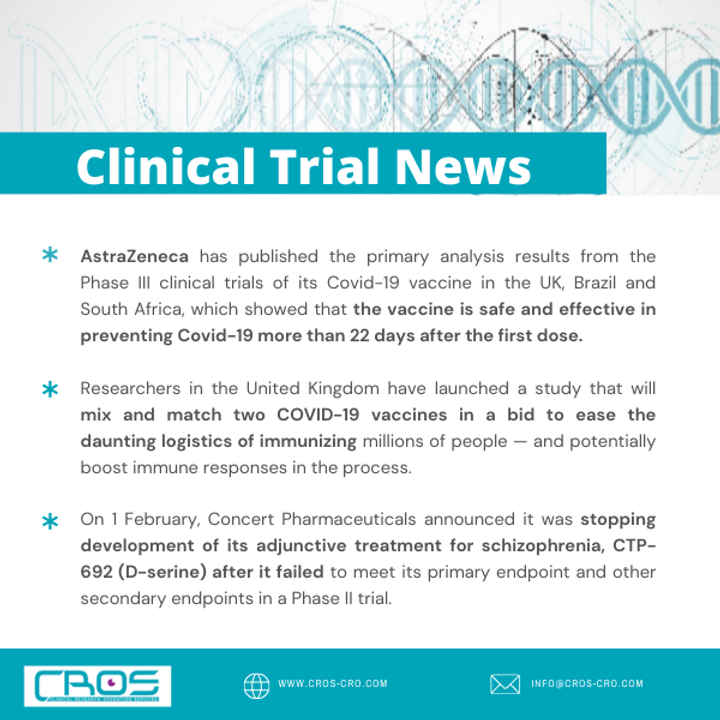Todays weeks news in Clinical Trials seem to shine a new light on the way of treating Covid-19.
The first interesting thing is the new vaccine that was co-invented by the University of Oxford and Vaccitech.
The vaccine uses a replication-deficient chimpanzee viral vector based on an adenovirus and has the genetic material of the SARS-CoV-2 spike protein.
The primary efficacy analysis was based on 17,177 subjects accruing 332 symptomatic cases from the Phase III UK (COV002), Brazil (COV003) and South Africa (COV005) trials.
According to the results, vaccine efficacy was 76% after the first dose, with protection maintained to the second dose. When inter-dose interval was 12 weeks or more, vaccine efficacy increased to 82%.
Furthermore, the analysis demonstrated the vaccine’s potential in reducing asymptomatic transmission of the virus, based on weekly swabs obtained from volunteers in the UK trial.
PCR positive readings decreased by 67% after a single dose and 50% after two doses, the data showed, which supports substantial impact on viral transmission.

As the number of potential vaccines seems to grow, researchers in the United Kingdom have launched a study that will mix and match two COVID-19 vaccines in a bid to ease the daunting logistics of immunizing millions of people — and potentially boost immune responses in the process.
Most coronavirus vaccines are given as two injections: an initial ‘prime’ dose followed by a ‘boost’ to stimulate the immune system’s memory cells and amplify the immune response. The clinical trial will test participants’ immune responses to receiving one shot of a coronavirus vaccine produced by Oxford and drug firm AstraZeneca — which uses a harmless virus to carry a key coronavirus gene into cells — and one shot of the vaccine produced by drug company Pfizer, which uses RNA instructions to trigger an immune response. The trial, which is run by investigators at the University of Oxford, aims to begin enrollment on the 4th of February.
Vaccine developers often combine two vaccines to combat the same pathogen, and researchers are keen to deploy the strategy — known as a heterologous prime-boost — against the coronavirus. A heterologous prime-boost combination was approved last year by European regulators to protect against Ebola, and experimental HIV vaccines often rely on the strategy, says Dan Barouch, director of the Center for Virology and Vaccine Research at Beth Israel Deaconess Medical Center in Boston, Massachusetts. But it has yet to be tested for vaccines against COVID-19, which are typically given as a repeat injection of the same vaccine.
The ability to mix and match vaccines could make vaccination programmes more flexible: it would speed up the process and reduce the impact of any supply-chain disruptions. “It really makes the implementation much more simple,” said Mary Ramsay, head of immunization at Public Health England, at a press briefing on 3 February.
Oxford has said that it will also trial combinations of its COVID-19 vaccine with the Russian coronavirus vaccine, Sputnik V, which uses harmless viruses to shuttle components of the coronavirus into cells. Sputnik V, which this week was shown to have greater than 90% efficacy against COVID-19, is itself a heterologous prime-boost vaccine, consisting of different viral components in the first and second doses.

Lastly, unfortunately the double-blind, randomised, placebo-controlled trial treatment for schizophrenia, CTP-692 (D-serine) after it failed to meet its primary endpoint and other secondary endpoints in a Phase II trial. The research was conducted in 325 patients and had failed to demonstrate significant improvement compared to placebo for any of the doses of CTP-692 used in the trial (1g, 2g, or 4g once daily), measured by the change in the Positive and Negative Syndrome Scale (PANSS) total score at 12 weeks compared to baseline. Furthermore, no significant improvements were seen in the PANSS positive or negative symptoms subscales.
One key unmet need in the schizophrenia market is for drugs with improved safety profiles. While there is evidence in the literature that D-serine can improve outcomes in patients with schizophrenia as adjunctive therapy, it is associated with renal safety issues. CTP-692 was designed to improve upon the renal safety issues, so CTP-692’s failure to demonstrate efficacy in the Phase II trial is especially disappointing given that the majority of adverse effects reported in the trial were mild in severity and equally distributed across the different CTP-692 dose and placebo groups.
Cognitive impairments are common in schizophrenia patients and contribute significantly to the disability of the disease, as these symptoms persist during periods of remission. Although there is a high number of established atypical antipsychotic products on the schizophrenia market, they are only able to effectively manage the positive symptoms of the disorder. Therefore, there is a high unmet need for effective therapies to treat cognitive impairments associated with schizophrenia.
Because D-serine has been linked to having effects on cognition, it was hoped that CTP-692 would demonstrate a positive effect on cognitive impairment along with efficacy. CTP-692’s failure in the trial leaves the market open for therapies that treat cognitive impairment associated with schizophrenia. The approval of any such drug would likely to lead to a large uptake of patients.
Concert Pharmaceuticals’ shares fell almost 50% after discontinuing CTP-692, one of its two pipeline assets. The company will now be focused on its remaining pipeline product, CTP-543, which is being investigated as a treatment for alopecia areata.
CTP-543 is currently in Phase III development in the US, having shown promising results in Phase II trials. Last year, Concert Pharmaceuticals announced that patients treated with CTP-543 showed continued maintenance of hair growth in a long-term extension study following its Phase II trial. GlobalData forecasts that CTP-543 will have annual revenue of $228M by 2026 in the US.
Latest post




